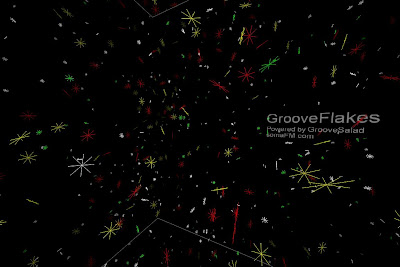
I'm a big fan of SomaFM. In particular, their Groove Salad radio station. I'd been wanting to learn how to integrate audio into my Processing sketches via the Minim library. Originally, when I'd started my 'Perlin Particle' sketches (see three previous posts), they were spun out of the idea of making falling snowflakes. I wanted to have the snowflakes to "move" through the air with some randomness, and that's where the Perlin noise fit in. Once I solved that, I was able to move back to my snowflakes, and in particular, audio processing.
I got my "GrooveFlakes" sketch up and running. It streams in the GrooveSalad playlist, and samples the beats. When the kick, snare, or hat hits, the flakes will "pulse" to the music.
You can get the source, over on my Processing Wiki HERE. I still don't have a web site where I can upload the actual app yet... (lazy... maybe next year...).

